check engine FORD E SERIES 1997 4.G User Guide
[x] Cancel search | Manufacturer: FORD, Model Year: 1997, Model line: E SERIES, Model: FORD E SERIES 1997 4.GPages: 192, PDF Size: 3.44 MB
Page 130 of 192
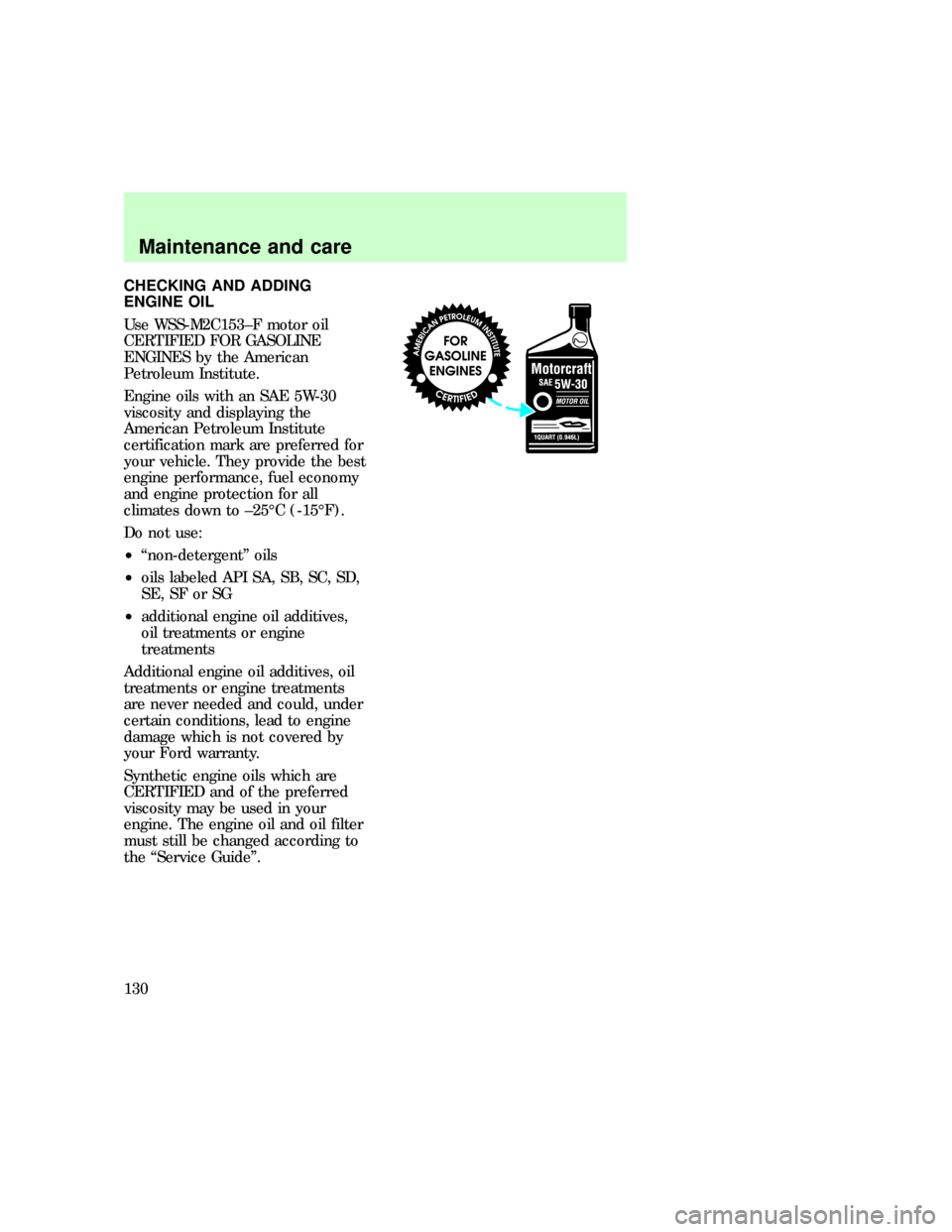
CHECKING AND ADDING
ENGINE OIL
Use WSS-M2C153±F motor oil
CERTIFIED FOR GASOLINE
ENGINES by the American
Petroleum Institute.
Engine oils with an SAE 5W-30
viscosity and displaying the
American Petroleum Institute
certification mark are preferred for
your vehicle. They provide the best
engine performance, fuel economy
and engine protection for all
climates down to ±25ÉC (-15ÉF).
Do not use:
²ªnon-detergentº oils
²oils labeled API SA, SB, SC, SD,
SE, SF or SG
²additional engine oil additives,
oil treatments or engine
treatments
Additional engine oil additives, oil
treatments or engine treatments
are never needed and could, under
certain conditions, lead to engine
damage which is not covered by
your Ford warranty.
Synthetic engine oils which are
CERTIFIED and of the preferred
viscosity may be used in your
engine. The engine oil and oil filter
must still be changed according to
the ªService Guideº.
eco_checking_engine_oil
Maintenance and care
130
Page 131 of 192
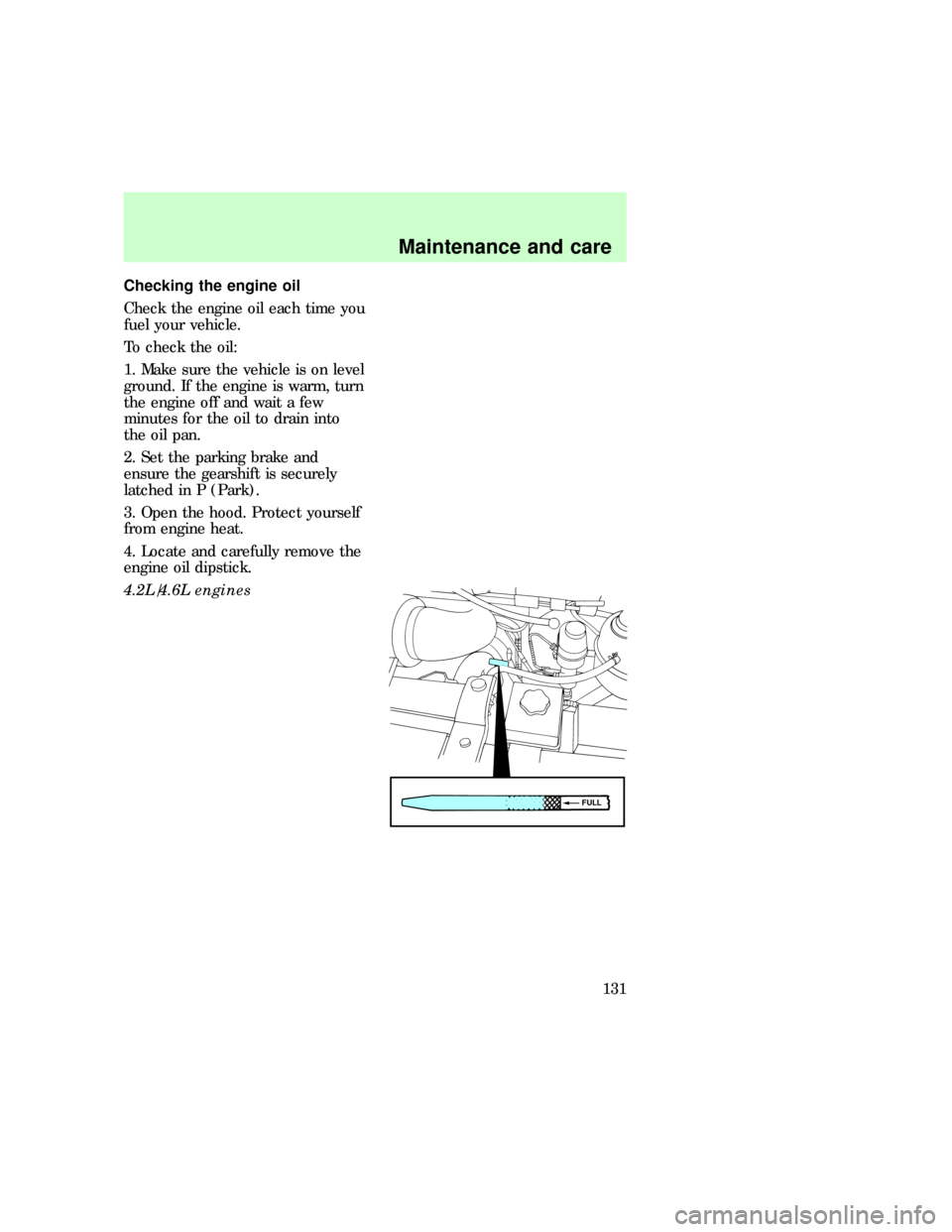
Checking the engine oil
Check the engine oil each time you
fuel your vehicle.
To check the oil:
1. Make sure the vehicle is on level
ground. If the engine is warm, turn
the engine off and wait a few
minutes for the oil to drain into
the oil pan.
2. Set the parking brake and
ensure the gearshift is securely
latched in P (Park).
3. Open the hood. Protect yourself
from engine heat.
4. Locate and carefully remove the
engine oil dipstick.
4.2L/4.6L engines
ADDFULL
Maintenance and care
131
Page 133 of 192
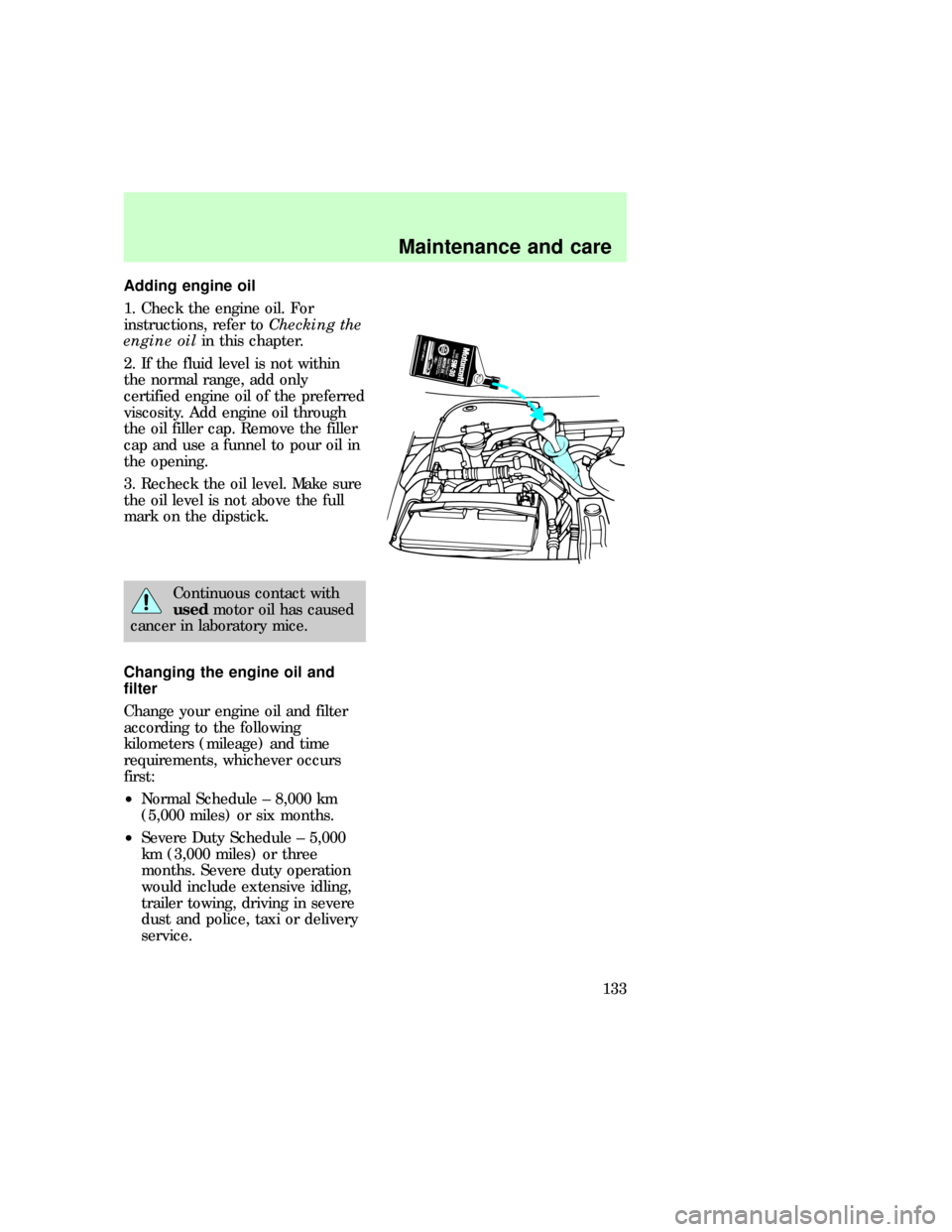
Adding engine oil
1. Check the engine oil. For
instructions, refer toChecking the
engine oilin this chapter.
2. If the fluid level is not within
the normal range, add only
certified engine oil of the preferred
viscosity. Add engine oil through
the oil filler cap. Remove the filler
cap and use a funnel to pour oil in
the opening.
3. Recheck the oil level. Make sure
the oil level is not above the full
mark on the dipstick.
Continuous contact with
usedmotor oil has caused
cancer in laboratory mice.
Changing the engine oil and
filter
Change your engine oil and filter
according to the following
kilometers (mileage) and time
requirements, whichever occurs
first:
²Normal Schedule ± 8,000 km
(5,000 miles) or six months.
²Severe Duty Schedule ± 5,000
km (3,000 miles) or three
months. Severe duty operation
would include extensive idling,
trailer towing, driving in severe
dust and police, taxi or delivery
service.
com_oil_and_filter_change.01
Maintenance and care
133
Page 134 of 192
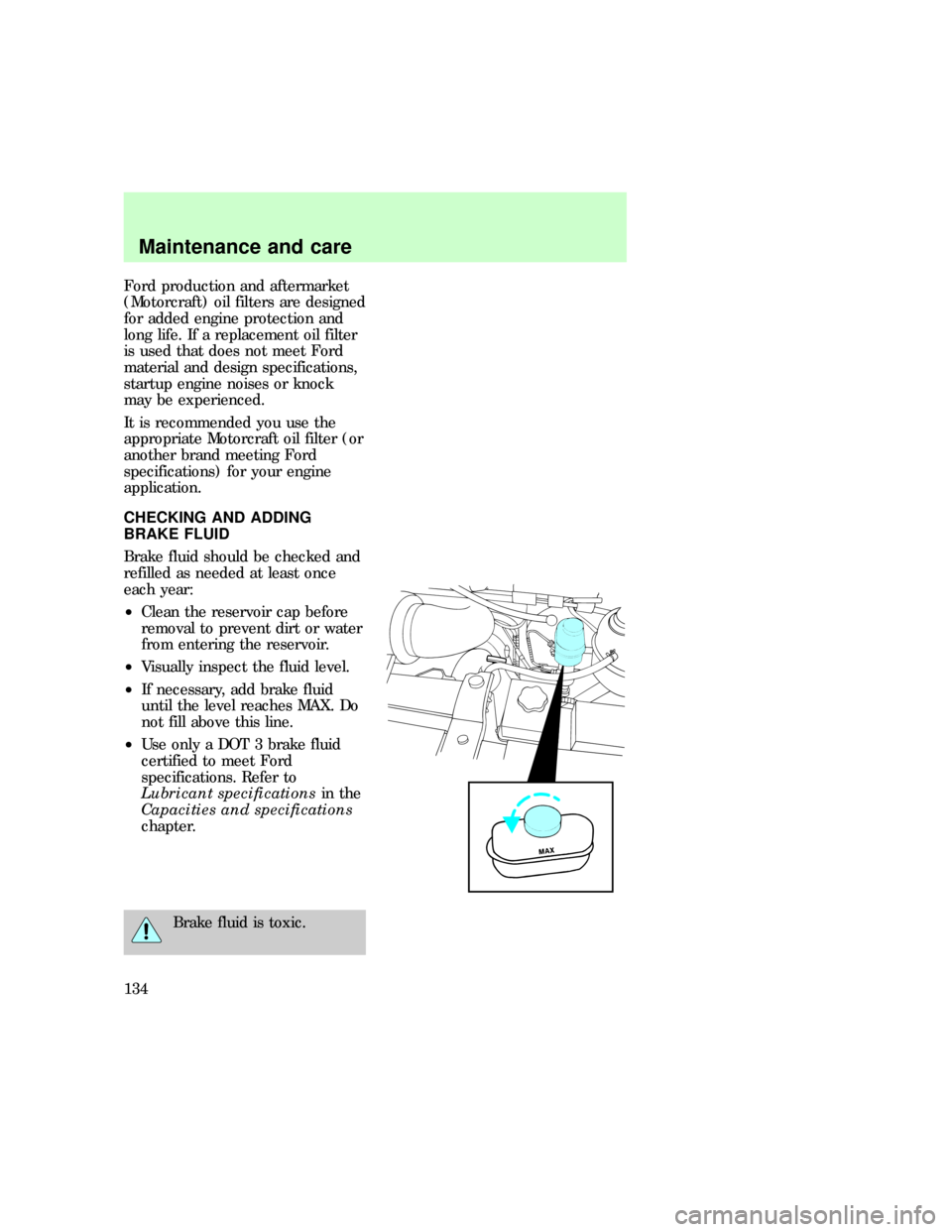
Ford production and aftermarket
(Motorcraft) oil filters are designed
for added engine protection and
long life. If a replacement oil filter
is used that does not meet Ford
material and design specifications,
startup engine noises or knock
may be experienced.
It is recommended you use the
appropriate Motorcraft oil filter (or
another brand meeting Ford
specifications) for your engine
application.
CHECKING AND ADDING
BRAKE FLUID
Brake fluid should be checked and
refilled as needed at least once
each year:
²Clean the reservoir cap before
removal to prevent dirt or water
from entering the reservoir.
²Visually inspect the fluid level.
²If necessary, add brake fluid
until the level reaches MAX. Do
not fill above this line.
²Use only a DOT 3 brake fluid
certified to meet Ford
specifications. Refer to
Lubricant specificationsin the
Capacities and specifications
chapter.
Brake fluid is toxic.
com_checking-adding_fluid.01
Maintenance and care
134
Page 136 of 192

Adding washer fluid
The vehicle's windshield washer
reservoir is located on the
passenger side of the engine
compartment. If fluid needs to be
added to the reservoir:
²Lift the windshield reservoir
cover.
²Add enough washer fluid to fill
the reservoir.
CHECKING AND ADDING
ENGINE COOLANT
Check the level of the coolant in
the reservoir at least once a
month. Be sure to read and
understandPrecautions when
servicing your vehiclein this
chapter.
If the engine coolant has not been
checked for a long period of time,
the engine coolant reservoir may
eventually empty. If this occurs,
add engine coolant to the coolant
reservoir. For more information on
engine coolant maintenance, refer
toAdding engine coolantin this
chapter.
MAX FILL
MIN FILL
com_checking-adding_coolant.01
Maintenance and care
136
Page 138 of 192
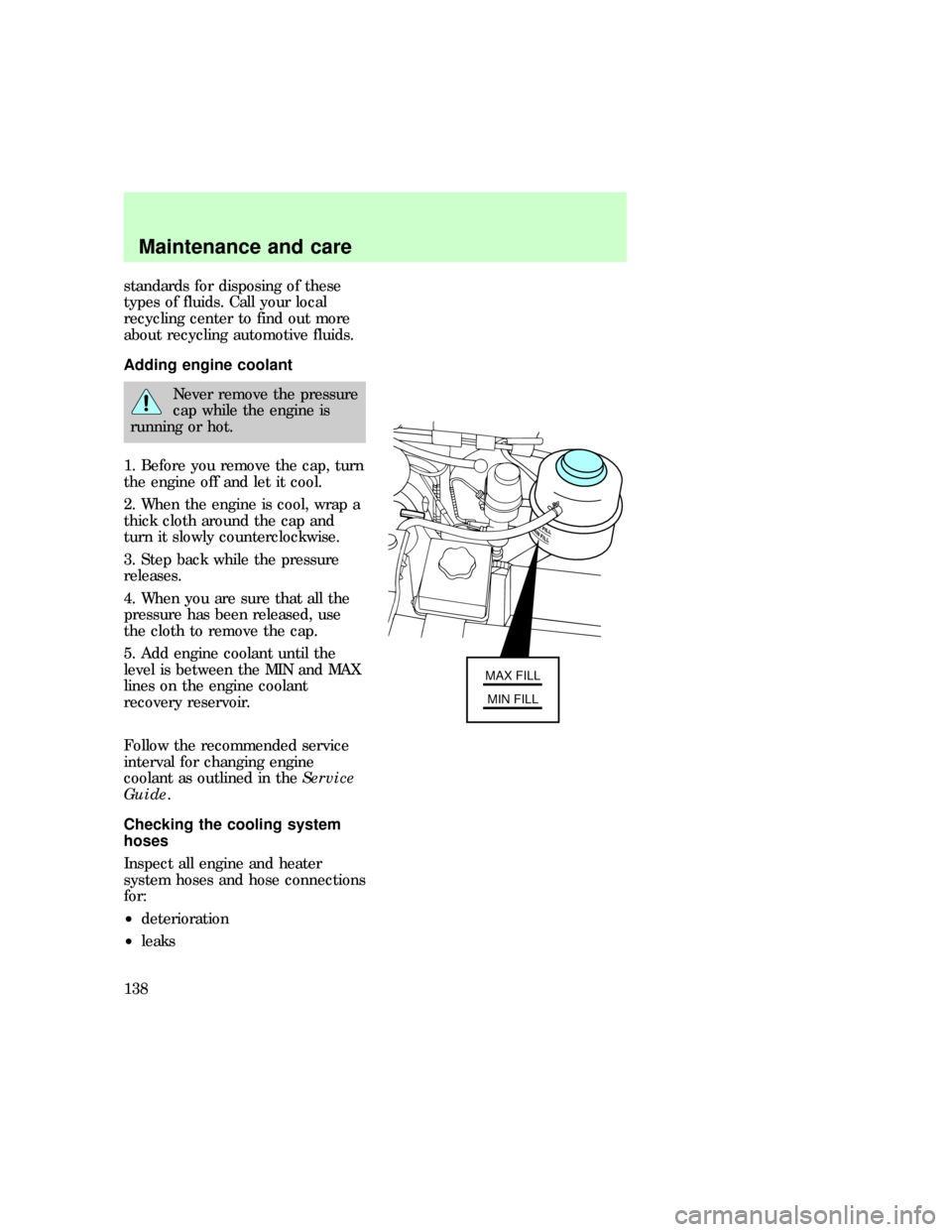
standards for disposing of these
types of fluids. Call your local
recycling center to find out more
about recycling automotive fluids.
Adding engine coolant
Never remove the pressure
cap while the engine is
running or hot.
1. Before you remove the cap, turn
the engine off and let it cool.
2. When the engine is cool, wrap a
thick cloth around the cap and
turn it slowly counterclockwise.
3. Step back while the pressure
releases.
4. When you are sure that all the
pressure has been released, use
the cloth to remove the cap.
5. Add engine coolant until the
level is between the MIN and MAX
lines on the engine coolant
recovery reservoir.
Follow the recommended service
interval for changing engine
coolant as outlined in theService
Guide.
Checking the cooling system
hoses
Inspect all engine and heater
system hoses and hose connections
for:
²deterioration
²leaks
MAX FILL
MIN FILL
eco_adding_coolant
eco_checking_hoses
Maintenance and care
138
Page 140 of 192
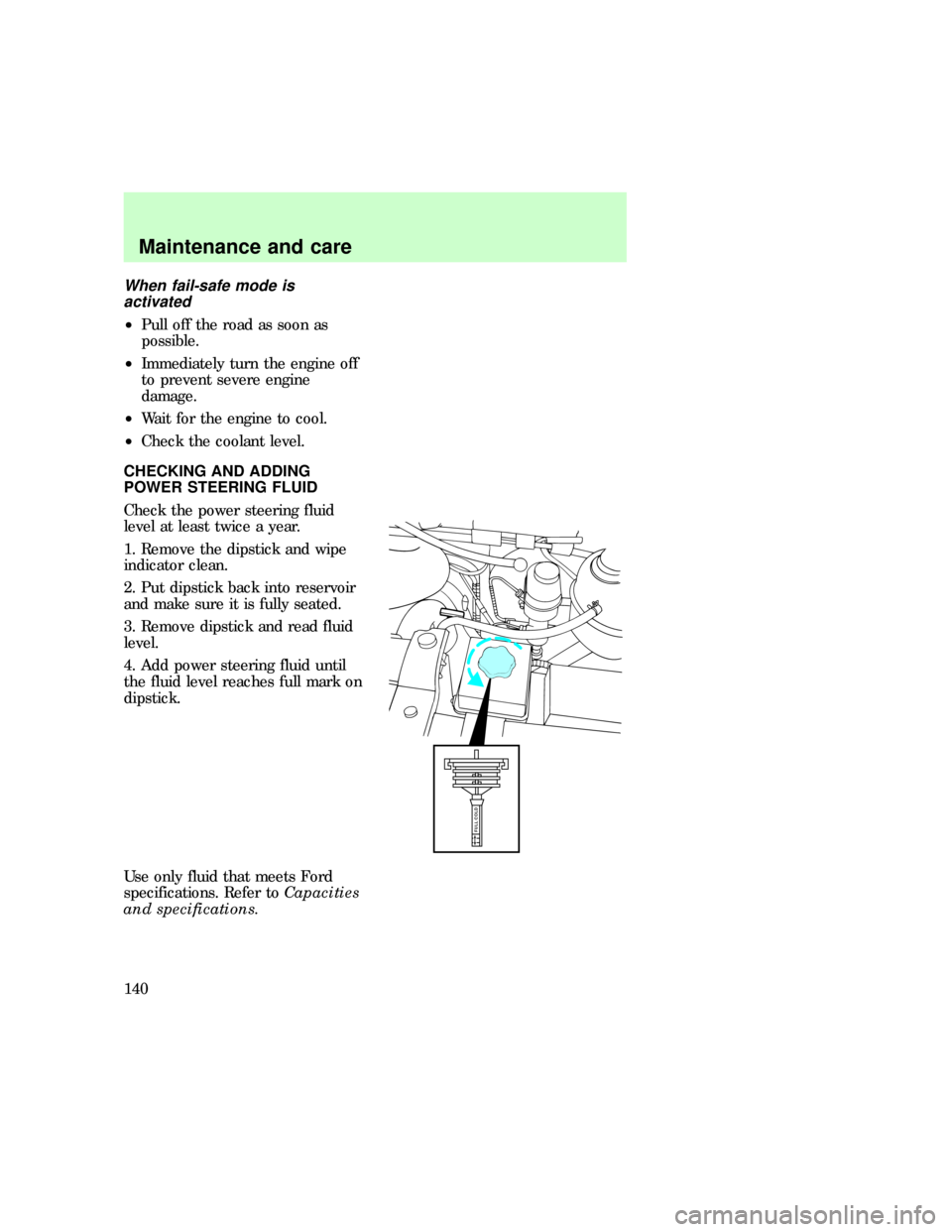
When fail-safe mode is
activated
²Pull off the road as soon as
possible.
²Immediately turn the engine off
to prevent severe engine
damage.
²Wait for the engine to cool.
²Check the coolant level.
CHECKING AND ADDING
POWER STEERING FLUID
Check the power steering fluid
level at least twice a year.
1. Remove the dipstick and wipe
indicator clean.
2. Put dipstick back into reservoir
and make sure it is fully seated.
3. Remove dipstick and read fluid
level.
4. Add power steering fluid until
the fluid level reaches full mark on
dipstick.
Use only fluid that meets Ford
specifications. Refer toCapacities
and specifications.
FULL COLD
eco_power_steering
eco_checking_adding_autotrans
Maintenance and care
140
Page 142 of 192
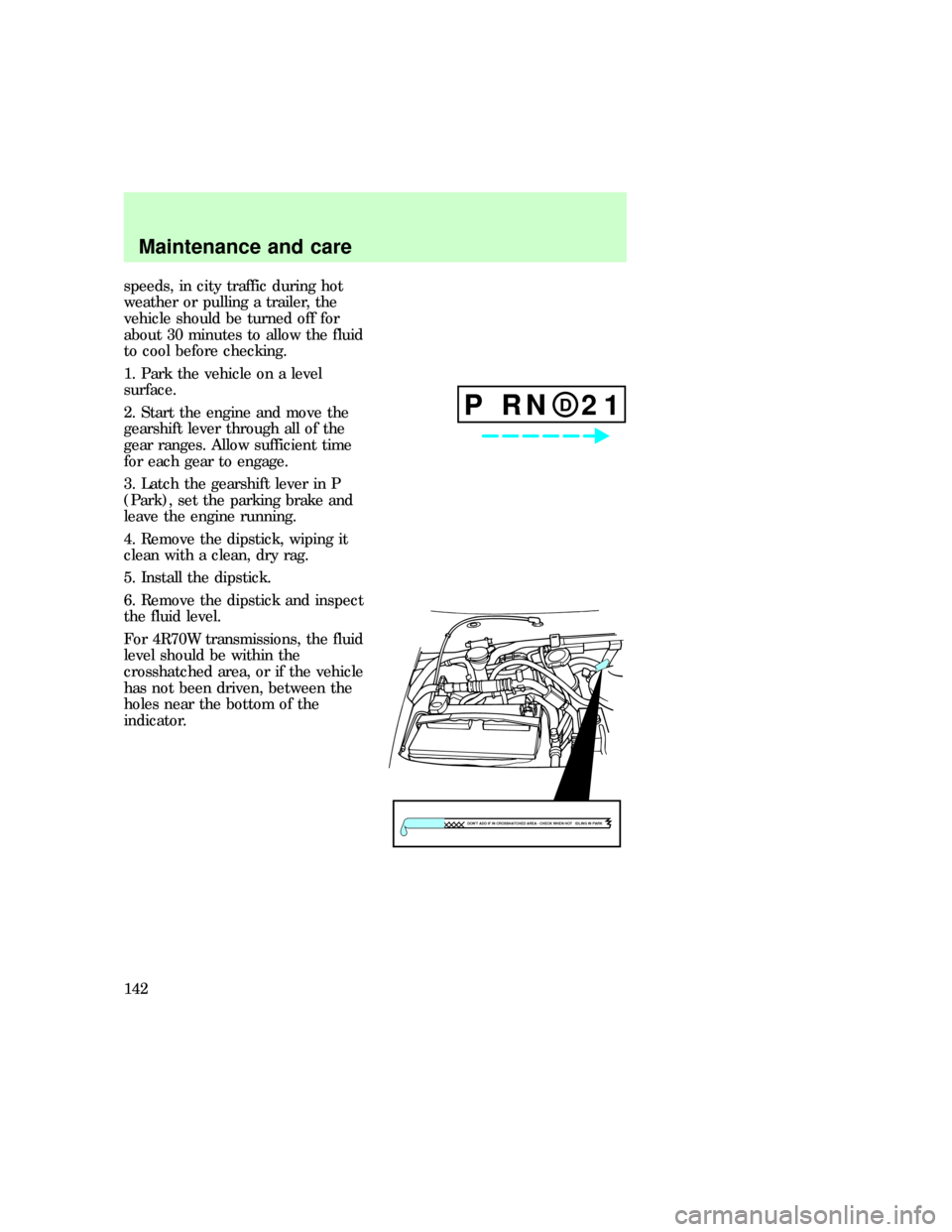
speeds, in city traffic during hot
weather or pulling a trailer, the
vehicle should be turned off for
about 30 minutes to allow the fluid
to cool before checking.
1. Park the vehicle on a level
surface.
2. Start the engine and move the
gearshift lever through all of the
gear ranges. Allow sufficient time
for each gear to engage.
3. Latch the gearshift lever in P
(Park), set the parking brake and
leave the engine running.
4. Remove the dipstick, wiping it
clean with a clean, dry rag.
5. Install the dipstick.
6. Remove the dipstick and inspect
the fluid level.
For 4R70W transmissions, the fluid
level should be within the
crosshatched area, or if the vehicle
has not been driven, between the
holes near the bottom of the
indicator.
P RN 21D
DON'T ADD IF IN CROSSHATCHED AREA - CHECK WHEN HOT IDLING IN PARK
Maintenance and care
142
Page 145 of 192
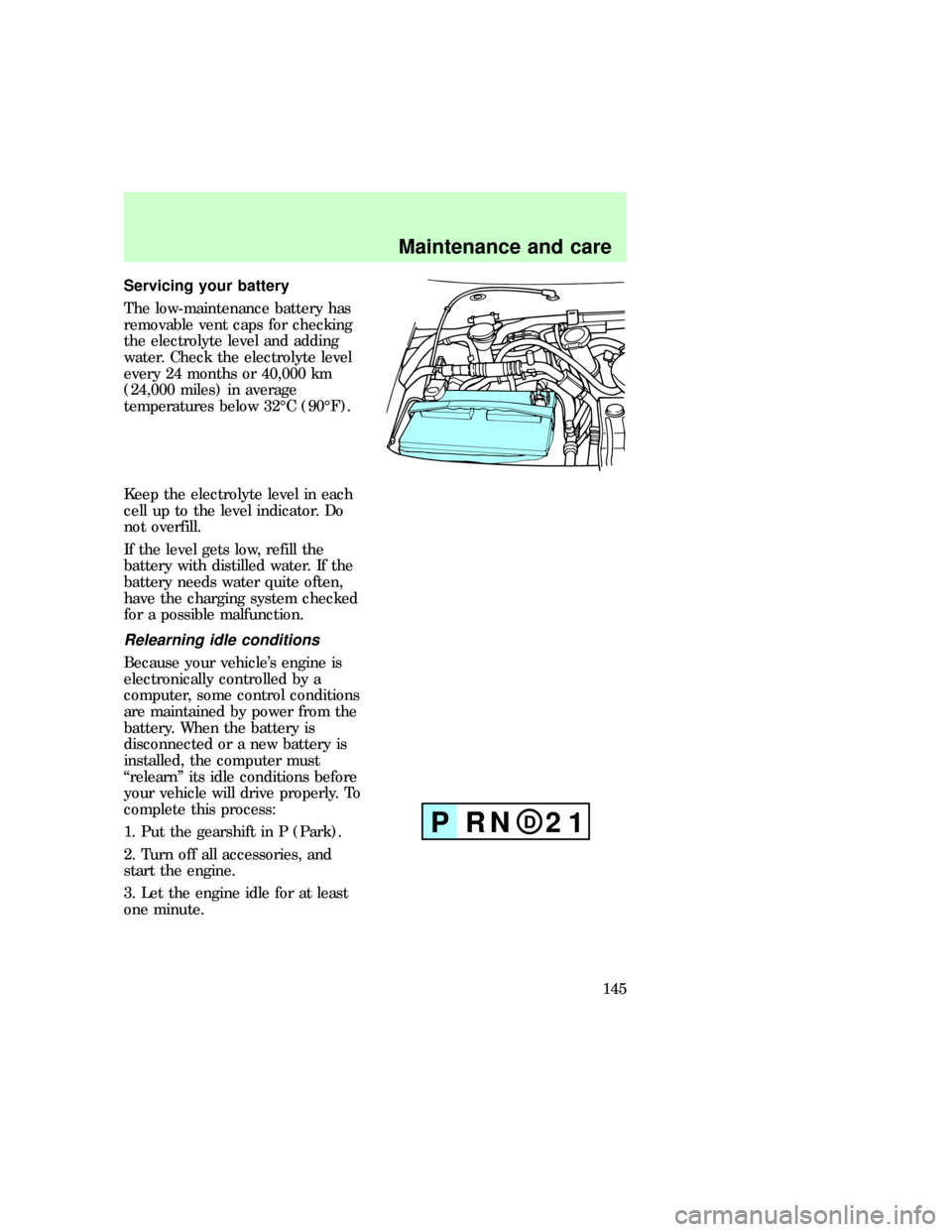
Servicing your battery
The low-maintenance battery has
removable vent caps for checking
the electrolyte level and adding
water. Check the electrolyte level
every 24 months or 40,000 km
(24,000 miles) in average
temperatures below 32ÉC (90ÉF).
Keep the electrolyte level in each
cell up to the level indicator. Do
not overfill.
If the level gets low, refill the
battery with distilled water. If the
battery needs water quite often,
have the charging system checked
for a possible malfunction.
Relearning idle conditions
Because your vehicle's engine is
electronically controlled by a
computer, some control conditions
are maintained by power from the
battery. When the battery is
disconnected or a new battery is
installed, the computer must
ªrelearnº its idle conditions before
your vehicle will drive properly. To
complete this process:
1. Put the gearshift in P (Park).
2. Turn off all accessories, and
start the engine.
3. Let the engine idle for at least
one minute.
DPRN 21
Maintenance and care
145
Page 162 of 192
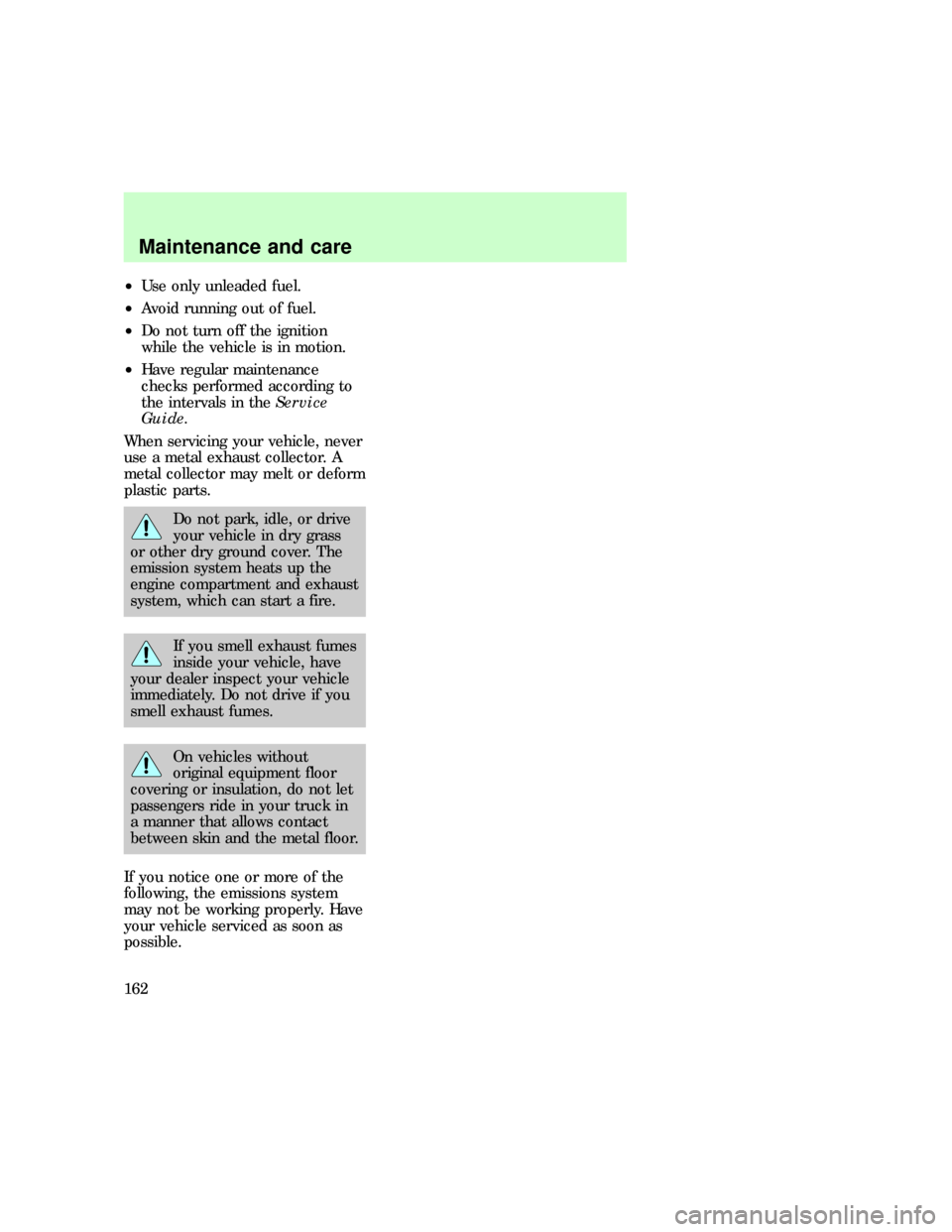
²Use only unleaded fuel.
²Avoid running out of fuel.
²Do not turn off the ignition
while the vehicle is in motion.
²Have regular maintenance
checks performed according to
the intervals in theService
Guide.
When servicing your vehicle, never
use a metal exhaust collector. A
metal collector may melt or deform
plastic parts.
Do not park, idle, or drive
your vehicle in dry grass
or other dry ground cover. The
emission system heats up the
engine compartment and exhaust
system, which can start a fire.
If you smell exhaust fumes
inside your vehicle, have
your dealer inspect your vehicle
immediately. Do not drive if you
smell exhaust fumes.
On vehicles without
original equipment floor
covering or insulation, do not let
passengers ride in your truck in
a manner that allows contact
between skin and the metal floor.
If you notice one or more of the
following, the emissions system
may not be working properly. Have
your vehicle serviced as soon as
possible.
Maintenance and care
162